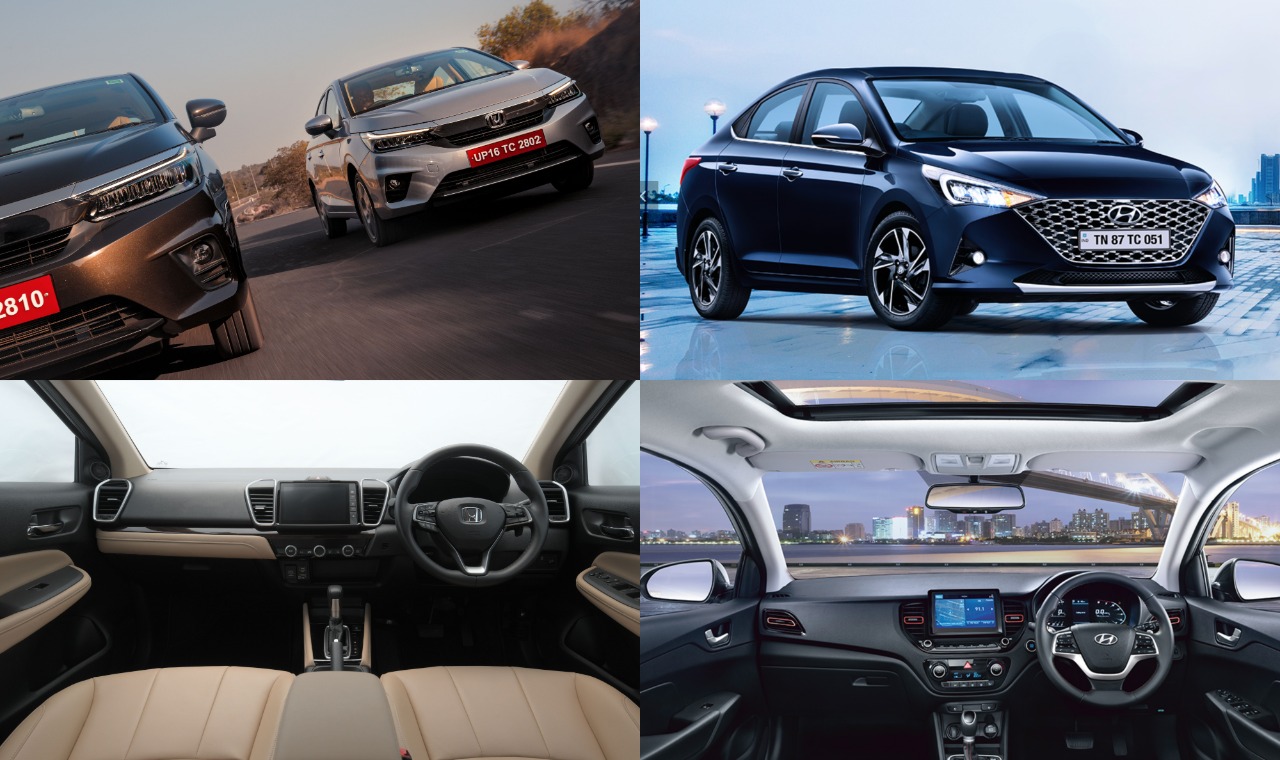

Hyundai upgraded its popular sedan the Hyundai Verna in the Indian market a few months ago, and the facelift model features styling changes on the outside, refreshed interiors and a BS6 compliant powertrain. Honda, on the other hand, is gearing up to launch the all-new 5th generation Honda City sedan on the 15th of July in the Indian market, which comes with an all-new design on the exterior, new interiors and new BS6 compliant petrol and diesel engines.
When compared, the Hyundai Verna on the exterior measures in at 4440mm in length, 1729mm in width and 1475mm in height. The all-new Honda City is longer than the facelift Verna at 4549 mm wider with 1748 mm of overall width taller at 1489 mm but both cars come with an identical 2600 mm of wheelbase.
While the Hyundai Verna is slightly smaller than the Honda City, the naked eye both sedans appear similar in size on the outside and both come with exterior features such as multi-LED headlamps and LED tail lamps, on the inside, the Honda City offers more legroom and headroom but the Verna competes fiercely by offering comfort and convenience features such as wireless smartphone charging and ventilated driver and front passenger seat, which are missed out on the Honda City.
In term of comfort and convenience, the Honda City offers first-in-class features such as blind-spot-monitoring, Honda Connect with Telematics Control Unit (TCU) featuring Alexa remote capabilities, stitched soft pads with wooden embellishment on the dashboard, a 20.3-cm centrally mounted touchscreen infotainment system an analogue-digital instruments cluster with a 17.7-cm full-colour TFT multi-information display, electric sunroof, automatic climate control, rear AC vents, leather seat upholstery, multifunction leather-wrapped steering wheel and a leather-wrapped gear knob.
The Hyundai Verna offers an all-digital instruments cluster with a 10.67-cm multi-information display in the centre, 20.32-cm touchscreen infotainment system with Hyundai’s advanced BlueLink connected technology with remote access (Start/Stop, Climate Control Function etc), auto climate control, rear AC vents, wireless smartphone charging, an electric sunroof, rear manual curtains, cup holders, leather upholstery, leather-wrapped control mounted steering wheel and gear knob.
In the engine department, the Hyundai Verna comes with three engine options – Naturally-Aspirated Petrol, Diesel and Turbo-Petrol while the Honda offers the City in a Naturally-Aspirated Petrol and a Diesel powertrain in the Indian market the international market also gets a Turbo-Petrol ‘RS’ variant.
In detail, the powertrains offered on the Hyundai Verna are as follows-
The all-new Honda City comes with new EARTH DREAMS TECHNOLOGY powertrain with DOHC instead of the SOHC predecessor and claims to have improved performance, efficiency and NVH levels.
The Thai-Spec Honda City is also offered with a Turbo-Petrol motor on the sportier ‘RS’ trim which is rumoured to be evaluated for the Indian market. The Honda City RS is powered by a 1.0-litre three-cylinder turbocharged i-VTEC petrol motor that produces 122 HP of power and 173 Nm of torque mated to a 7-step CVT (Continuously Variable Transmission).
In terms of safety, both the Hyundai Verna and the Honda City feature a 6 airbag system, vehicle stability control, ABS, EBD, tyre pressure monitoring system, ISOFIX etc., but the Honda City adds to the safety quotient with its Lane Watch camera system which projects the driver’s blind spot on to the infotainment screen using a camera mounted under the left ORVM.